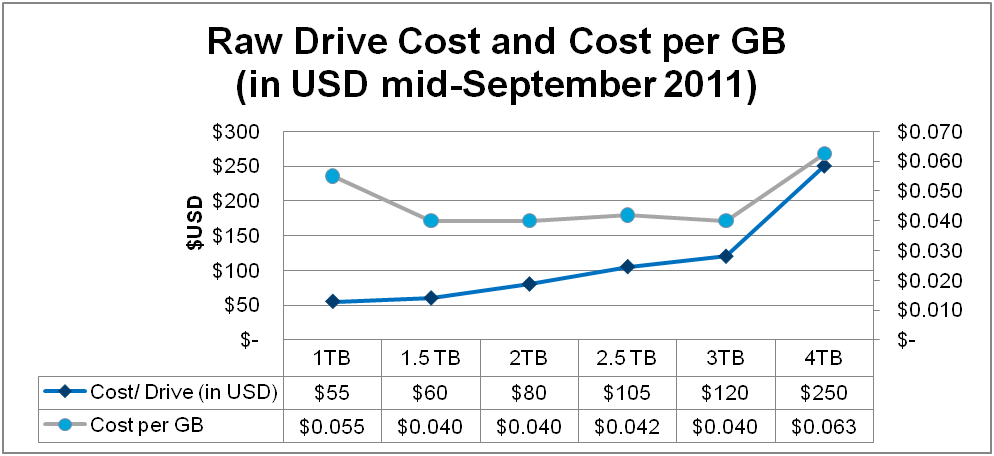With Seagate’s recent launch of their 4TB drive, it is time to look at the cost per GB on the different drives. To be clear, this is still a somewhat futile exercise since there is one 4TB model shipping, and that 4TB model is only available in an external format. It is still a somewhat interesting exercise to look at 1TB to 3TB drives at this point.
My methodology for picking drive prices was not the most sophisticated by any means. I looked at slower rotating 5400-5900rpm drives and looked at the general midpoint, excluding rebates (which are not as prevalent, luckily, in the rotating hard drive space.) For example, if I saw drives for $100, $105, and $110 in the shops I check regularly, I would ascribe that a $105/ drive cost. I keep track of this on a bi-weekly basis for my own purposes, but saw something interesting this week. The interesting thing is that there is a sweet spot in the market, and that sweet spot has certainly moved since the last time we undertook this with Western Digital 3TB drive introductions a year ago.

What one can see very clearly given today’s prices is a trend towards $0.040 per GB. 1TB drives seem to be suffering from the overhead of the casing, motors and etc that are not adequately offset by the capacity. 1.5TB drives currently occupy the low end of the pricing sweet spot. 2TB and 3TB drives follow similar trends towards $0.040/ GB.
One very interesting note here is the WD Green 2.5TB drive. As linked at Newegg.com it comes with a Highpoint RocketRAID 62x PCIe x1 dual port SATA III 6.0gbps controller at a very small price premium. If one has a need for such a controller it is an interesting proposition. The negative here is that the 2.5TB form factor is not very popular with most drive manufacturers (WD is the only one I could find with a 2.5TB drive.)
A key takeaway here is that the 4TB introduction has pushed 3TB drives to the $0.040 line and the 4TB drive is priced at the standard high-end premium, even taking away the external v. internal premium.
Bottom line, over the past twelve to eighteen months, we have seen the market develop a consistent cost/ GB in a way that we have not seen previously. What this practically means is that the most cost-effective drives to purchase are the largest drives since one pays less to connect fewer drives (see the 2010 article on port costs.)




Your article is stating 40 cents but your graph shows 4 cents. Which is it?
Typo fixed. Thanks Kyle for spotting.
I like the Idea of the larger drives, but what about the fact that a 3 or 4 TB drive is larger than a RAID used to be. Nobody is worried about the failure of a 3 or 4 TB drive like they would be about the fialure of a RAID 0 or even RAID 5. What would be the advantage (reliability wise not financial) of having a 4TB drive over a RAID 0 or RAID 5? This has always bugged me, can you shed some light on it?
So generally RAID 0 is going to be less reliable. RAID 0 gives you twice as many points of failure (everywhere from the physical controller port to the drive itself.)
RAID 5 can be more reliable since you can have one drive fail out of the population and then recover, even though you are three (or more) times as likely to see a drive fail.